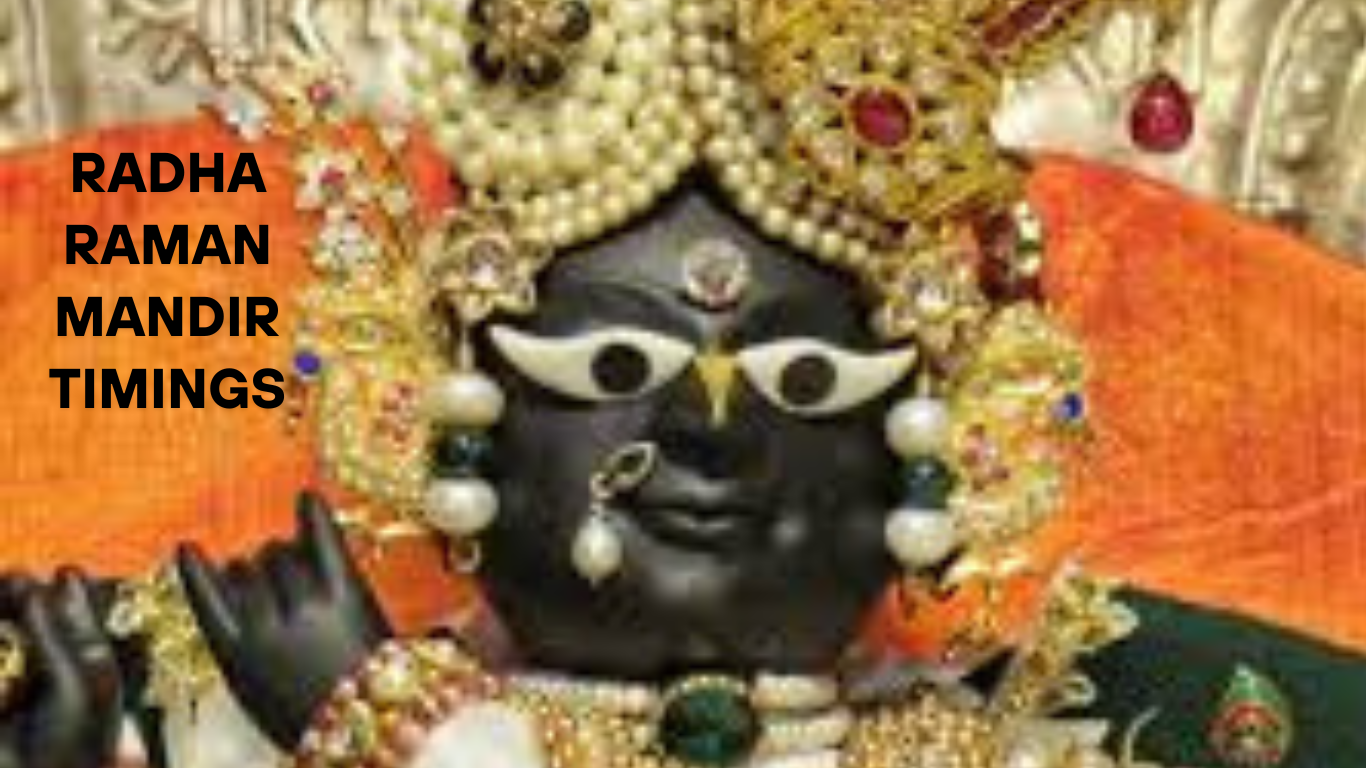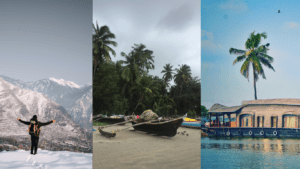Nestled in the heart of Vrindavan, the Radha Raman Mandir is a sacred haven that radiates devotion and serenity. Dedicated to Lord Krishna, worshipped here as Radha Ramana—meaning “the beloved of Sri Radha”—this 500-year-old temple is one of the seven most revered temples in Vrindavan. For first-time travellers, planning a visit to this divine abode requires understanding the Radha Raman Mandir timings, rituals, festivals, and practical tips to ensure a spiritually fulfilling experience. This comprehensive guide covers everything you need to know, from temple schedules to cultural insights, to make your pilgrimage seamless and memorable.
Introduction to Radha Raman Mandir
Vrindavan, located in Uttar Pradesh, India, is synonymous with the divine love of Lord Krishna and Radha. Among its many temples, the Radha Raman Mandir stands out for its historical significance, architectural charm, and the self-manifested deity of Lord Krishna. Established by Gopala Bhatta Goswami, a key figure among the six Goswamis of Vrindavan, the temple houses a unique deity that emerged from a sacred Shaligram Shila, a black stone revered in Vaishnavism. Unlike other temples, there is no separate idol of Radha Rani; instead, a symbolic crown or crest is placed beside Krishna to signify her presence.
The temple’s spiritual ambiance, coupled with its vibrant rituals and festivals, draws thousands of devotees annually. For first-time visitors, understanding the Radha Raman Mandir timings is crucial to participate in darshan (viewing of the deity), aartis (ceremonial worship), and other sacred practices. This guide provides a detailed breakdown of the temple’s schedule, along with tips to enhance your visit.
Radha Raman Mandir Timings: Daily Schedule
The Radha Raman Mandir operates on a structured daily schedule, with specific timings for darshan, aartis, and bhog (food offerings). These timings may vary slightly during festivals or special occasions, so it’s wise to check with temple authorities or reliable sources before planning your visit. Below is the standard schedule based on the most recent information:
Daily Darshan Timings
- Morning: 8:00 AM to 12:30 PM
- Evening: 6:00 PM to 8:00 PM (summer) / 5:30 PM to 9:00 PM (winter)
Aarti Timings
- Mangala Aarti: 4:00 AM (winter) / 5:30 AM (summer) – A serene pre-dawn ceremony to awaken the deity.
- Shringar Aarti: Follows Mangala Aarti, where the deity is adorned with clothes and ornaments.
- Raj Bhog Aarti: Around noon, after the main food offering to the deity.
- Uthapan Aarti: Evening, marking the deity’s awakening from an afternoon rest.
- Sandhya Aarti: Evening, a melodious ceremony with kirtans and lamps.
- Shayan Aarti: 8:00 PM (summer) / 9:00 PM (winter) – The final aarti before the deity retires for the night.
Note: The temple may have short breaks during the day for bhog and deity rest. A red bulb at the entrance indicates that darshan is closed, while a green bulb signals that it is open.
Best Time to Visit
For a peaceful experience, visit early in the morning during the Mangala Aarti or the morning darshan slot, when crowds are thinner. The evening Sandhya Aarti is also popular for its vibrant kirtans and spiritual atmosphere. The best months to visit are October to mid-April, when Vrindavan’s weather is pleasant, with temperatures ranging from 15°C to 30°C. Summers (May–June) can be scorching, and monsoons (July–September) may bring heavy rains, affecting travel plans.
History and Significance of Radha Raman Mandir
Understanding the temple’s history adds depth to your visit. The Radha Raman Mandir was established in 1542 by Gopala Bhatta Goswami, a disciple of Sri Chaitanya Mahaprabhu, a revered saint in Gaudiya Vaishnavism. The story of the deity’s manifestation is particularly captivating. Gopala Bhatta, longing for a tangible form of Krishna to worship, was gifted a Shaligram Shila. One night, after intense prayers, the Shila miraculously transformed into the deity of Radha Ramana, a small but exquisitely beautiful form of Krishna playing the flute in the tri-bhanga (three-fold bending) posture.
This self-manifested deity, only 12 inches tall, is considered alive by devotees, who believe it reciprocates their love and devotion. The temple’s sanctity is further enhanced by its association with Chaitanya Mahaprabhu, whose sacred kaupina (loin cloth) is preserved and displayed on special occasions. The temple’s kitchen fire, burning continuously for over 500 years, is another marvel, said to have been ignited by a saint’s mantras rather than a match.
The Radha Raman Mandir is a cornerstone of Gaudiya Vaishnavism, emphasizing the divine love between Radha and Krishna. Its rituals, performed by the Goswami families, follow strict traditional standards, making it one of Vrindavan’s most authentic spiritual centers. For first-time visitors, this historical context underscores the temple’s unique place in Hindu pilgrimage.
Festivals and Special Events at Radha Raman Mandir
The Radha Raman Mandir comes alive during festivals, offering devotees a chance to immerse in vibrant celebrations. Below are the major festivals and their significance:
1. Rama Navami (March–April)
Celebrated in the Chaitra month, this festival marks Lord Rama’s birth. The temple is adorned with lights and flowers, and special aartis are conducted. Devotees can witness the deity in festive attire during Brahmotsava.
2. Chandan Yatra (May–June)
A 21-day festival in the Jyestha month, where the deity is coated with sandalwood paste to provide relief from summer heat. The temple’s courtyard is filled with devotees chanting kirtans.
3. Jhulan Yatra (July–August)
Also known as the Swing Festival, this occurs in the Shravan month during the rainy season. The deities are placed on a gold-plated swing, and devotees sing and dance in devotion. This is a visually spectacular event, perfect for first-time visitors.
4. Krishna Janmashtami (August–September)
The birth of Lord Krishna is celebrated with grandeur. The temple hosts midnight aartis, abhishek (ritual bathing of the deity with milk), and bhog offerings. Thousands flock to Vrindavan, so plan your visit early.
5. Radhashtami (August–September)
Held 15 days after Janmashtami, this festival honors Radha Rani’s birth. Devotees observe a half-day fast, followed by Radha’s abhishek and a grand feast. The temple is beautifully decorated, creating a festive ambiance.
6. Kartika Month (October–November)
The entire month is dedicated to offering lamps to Krishna. Devotees participate in Deepotsava, lighting oil lamps to seek divine blessings. The temple’s spiritual energy is palpable during this time.
7. Balaram Purnima (July–August)
Celebrated in Shravan, this festival honors Krishna’s elder brother, Balaram. The deities are offered new outfits and special bhog, with devotees joining in prayers and kirtans.
Tip: Festival days are crowded, so arrive early and follow temple etiquette. Check the Vaishnav calendar for exact dates, as they follow the lunar calendar.
Rituals and Practices at Radha Raman Mandir
The temple’s rituals are steeped in tradition, offering devotees a chance to connect with the divine. Here’s what to expect:
Darshan
Darshan is the act of beholding the deity, considered a sacred exchange of love. The deity is adorned with intricate clothes, jewelry, and flowers, creating a mesmerizing sight. Devotees chant the Hare Krishna Mahamantra to deepen their connection with Radha Ramana.
Aartis
Aartis are ceremonial offerings of light, accompanied by bells, conch shells, and kirtans. The Mangala and Sandhya Aartis are particularly popular for their spiritual intensity. Visitors are encouraged to participate by singing or clapping along.
Bhog and Prasad
The temple kitchen, where the fire has burned for 500 years, prepares prasad (sanctified food) for the deity. Male members of the Goswami families cook the offerings, which are later distributed to devotees. Common prasad includes sweets like peda and laddoo.
Kirtans and Bhajans
The courtyard resonates with Braj Rasiya songs and kirtans, especially during evening aartis. These melodious chants create a powerful spiritual vibe, inviting devotees to join in.
Etiquette Tip: Maintain silence during rituals, remove footwear before entering, and dress modestly (preferably traditional attire like kurta or saree). Photography is generally prohibited inside the sanctum.
How to Reach Radha Raman Mandir
Located at Panchayat Mandir Shri Radharaman Ji Maharaj, Keshi Ghat, Vrindavan, Uttar Pradesh 281121, the temple is easily accessible. Here’s how to get there:
By Air
- Nearest Airport: Agra Airport (70 km) or Indira Gandhi International Airport, Delhi (150 km).
- From Delhi, hire a taxi or take a bus to Vrindavan (3–4 hours). Agra offers quicker access via cab (1–1.5 hours).
By Train
- Nearest Railway Station: Mathura Junction (13.5 km).
- From Mathura, take an autorickshaw, taxi, or local bus to Vrindavan (20–30 minutes). Vrindavan also has a smaller station (2 km from the temple) with limited connectivity.
By Road
- Vrindavan is 160 km from Delhi via the Yamuna Expressway. Buses and taxis are available from Delhi, Agra, and Mathura.
- Local transport options in Vrindavan include autorickshaws, cycle rickshaws, or e-rickshaws to reach Keshi Ghat.
By Foot
If staying in Vrindavan, the temple is within walking distance from popular areas like Nidhivan or Banke Bihari Temple. The narrow lanes of Vrindavan are best explored on foot, soaking in the town’s spiritual charm.
Travel Tip: Use GPS or ask locals for directions, as Vrindavan’s lanes can be confusing. Carry a water bottle and wear comfortable shoes for walking.
Accommodation Near Radha Raman Mandir
Vrindavan offers a range of accommodation options catering to different budgets. Here are some recommendations near the temple:
Budget Stays
- Brijwasi Royal: A clean, affordable hotel with basic amenities (1 km from the temple).
- Nidhivan Sarovar Portico: Offers simple rooms and vegetarian dining (1.5 km).
Mid-Range Hotels
- Krishnam Resort: Comfortable rooms with modern facilities (2 km).
- MVT Guesthouse: Popular among devotees, with a vegetarian restaurant (2.2 km).
Luxury Options
- Kridha Residency: A premium hotel with spacious rooms and excellent service (3 km).
- Hotel Basera Brij Bhoomi: Offers a blend of comfort and tradition (2.5 km).
Ashrams and Guesthouses
- ISKCON Guesthouse: Ideal for spiritual seekers, with kirtans and prasad (2 km).
- Radha Raman Vedic Temple Guesthouse: Offers a devotional ambiance, close to the temple.
Booking Tip: Book in advance during festival seasons (Janmashtami, Holi, Kartika) as accommodations fill up quickly. Check for hotels offering guided temple tours for a hassle-free experience.
Things to Do Around Radha Raman Mandir
Vrindavan is a treasure trove of spiritual and cultural experiences. Here are some nearby attractions to complement your temple visit:
1. Nidhivan (0.5 km)
A mystical forest associated with Krishna’s Rasleela. Visit in the evening to witness the serene ambiance and the Priya Priyatam Temple.
2. Banke Bihari Temple (1 km)
One of Vrindavan’s most famous temples, known for its lively darshan and vibrant aartis. Arrive early to avoid crowds.
3. Prem Mandir (3 km)
A stunning marble temple with light shows and beautifully landscaped gardens. Open from 5:30 AM to 9:00 PM.
4. ISKCON Temple (2 km)
Famous for its kirtans and vegetarian restaurant. Join the evening aarti for a soulful experience.
5. Keshi Ghat (0.2 km)
A picturesque ghat on the Yamuna River, ideal for evening aartis and boat rides. It’s a short walk from the temple.
6. Seva Kunj (1 km)
A sacred garden where Krishna is believed to have performed Rasleela with Radha. Visit during the day for a peaceful retreat.
Activity Tip: Hire a local guide to learn about Vrindavan’s legends and history. Many temples have specific timings, so plan your itinerary to cover multiple sites efficiently.
Local Cuisine and Dining Options
Vrindavan’s cuisine is predominantly vegetarian, reflecting its spiritual ethos. Here are some must-try dishes and dining spots near the temple:
Popular Dishes
- Peda: Vrindavan’s famous milk-based sweet, available at local shops.
- Kachori and Sabzi: A savory snack perfect for breakfast.
- Lassi: A refreshing yogurt-based drink, often flavored with saffron.
- Chole Bhature: A hearty meal available at street stalls.
Recommended Restaurants
- 11 Flowers Rooftop Cafe (2.2 km): Offers Italian and Indian vegetarian dishes with a scenic view.
- MVT Restaurant (2.2 km): Known for Mexican and Italian vegetarian options, ideal for international travelers.
- Govinda’s Restaurant (1.6 km): ISKCON’s eatery serving sattvic (pure) vegetarian meals.
- Pizza Bite’n’Slice (0.2 km): A quick stop for vegetarian pizzas and fast food.
Dining Tip: Try prasad from the temple for a blessed meal. Avoid eating non-vegetarian food or consuming alcohol in Vrindavan to respect local customs.
Practical Tips for First-Time Visitors
To ensure a smooth and enriching visit to the Radha Raman Mandir, keep these tips in mind:
1. Plan Around Timings: Check the temple’s schedule and arrive early for aartis or darshan to avoid crowds. Confirm festival dates via the temple’s official website or local tour operators.
2. Dress Appropriately: Wear modest clothing (e.g., kurta, saree, or dhoti). Avoid shorts, sleeveless tops, or revealing outfits. Women may need to cover their heads during rituals.
3. Follow Temple Rules: Remove footwear, maintain silence, and avoid touching the deity or altar. Photography is restricted inside the sanctum.
4. Stay Hydrated: Carry a water bottle, especially in summer. Vrindavan’s narrow lanes can be tiring, so take breaks as needed.
5. Beware of Monkeys: Vrindavan has many monkeys, so secure your belongings and avoid carrying food openly.
6. Hire a Guide: A knowledgeable guide can enhance your understanding of the temple’s history and rituals. Many are available near Keshi Ghat.
7. Respect Local Customs: Vrindavan is a sacred town, so refrain from smoking, drinking, or loud behavior. Greet locals with “Hare Krishna” for a warm response.
8. Cash and Connectivity: Carry cash for small expenses like rickshaws or prasad, as some areas may not accept digital payments. Mobile networks work well, but Wi-Fi is limited.
9. Safety Precautions: Vrindavan is generally safe, but stick to well-lit areas at night and avoid isolated lanes. Keep emergency contacts handy.
10. Combine with a Tour: Book a Mathura-Vrindavan tour package for a guided experience covering Radha Raman Mandir and other key sites like Krishna Janmabhoomi and Govardhan Hill.
Spiritual Significance for Devotees
For devotees, the Radha Raman Mandir is more than a temple—it’s a portal to divine love. The deity, Radha Ramana, is believed to reciprocate with sincere devotees, offering blessings and spiritual fulfillment. Chanting the Hare Krishna Mahamantra in the temple’s courtyard or meditating at the samadhi of Gopala Bhatta Goswami can be deeply transformative. The temple’s rituals, rooted in Gaudiya Vaishnavism, emphasize bhakti (devotion) as the path to connect with Krishna.
First-time visitors may find the temple’s spiritual energy overwhelming yet uplifting. Participating in kirtans, offering flowers, or simply sitting in the courtyard can evoke a sense of peace and purpose. The temple’s Goswami families, who have served the deity for generations, create an atmosphere of warmth and inclusivity, welcoming all who seek Krishna’s grace.
FAQs About Radha Raman Mandir Timings
Q1: What are the opening hours of Radha Raman Mandir?
The temple is open daily from 8:00 AM to 12:30 PM and 6:00 PM to 8:00 PM (summer) or 5:30 PM to 9:00 PM (winter). Aartis occur at specific times, starting with Mangala Aarti at 4:00 AM (winter) or 5:30 AM (summer).
Q2: Is there an entry fee for Radha Raman Mandir?
No, entry to the temple is free for all visitors.
Q3: When is the best time to visit the temple?
The ideal time is October to mid-April for pleasant weather. Early morning or evening aartis offer a serene experience.
Q4: Are there special timings during festivals?
Yes, festival days like Janmashtami and Radhashtami have extended darshan and special aartis. Check the Vaishnav calendar or temple website for updates.
Q5: Can non-Hindus visit the temple?
Yes, the temple welcomes people of all faiths, provided they respect its customs and dress modestly.
Q6: Is photography allowed inside the temple?
Photography is generally prohibited inside the sanctum but may be allowed in the courtyard. Seek permission from temple authorities.
Conclusion
The Radha Raman Mandir is a spiritual gem that embodies Vrindavan’s timeless devotion to Lord Krishna. By understanding the Radha Raman Mandir timings—from daily darshan to aarti schedules—you can plan a visit that aligns with your spiritual and travel goals. Whether you’re drawn to the temple’s self-manifested deity, its vibrant festivals, or its serene ambiance, this sacred space promises a transformative experience.
For first-time travellers, combining your visit with Vrindavan’s other attractions, savoring local cuisine, and following practical tips will ensure a memorable pilgrimage. Book a guided tour with operators like Mathura Vrindavan Tourism for a seamless journey, and immerse yourself in the divine love of Radha and Krishna. As you step into the Radha Raman Mandir, let the chants of “Hare Krishna” and the sight of the radiant deity fill your heart with peace and devotion.




